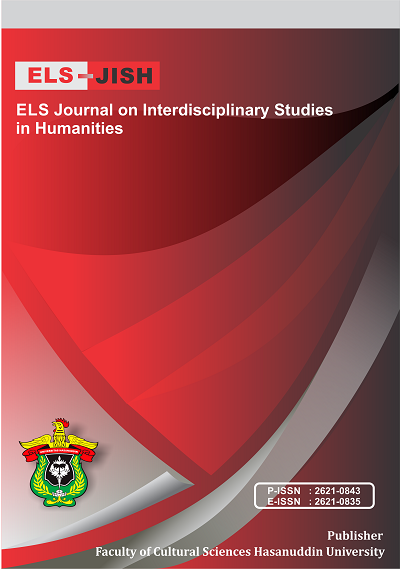Transitivity System in Hotel Slogans: Systemic Functional Linguistics Study
DOI:
https://doi.org/10.34050/els-jish.v3i2.10127Keywords:
Ideational meaning, Transitivity system, Systemic Functional Linguistics, Hotel SloganAbstract
Abstract
Three metafunctions of meaning in Systemic Functional Linguistics are interpersonal meaning, textual meaning, and ideational meaning. In ideational meaning, it is realized through the transitivity system (Halliday, 2004). As for this study, it focuses on the analysis of processes type classification and what type of process that dominant in Bandung hotel slogans based on Halliday’s theory about transitivity. To present the findings, a qualitative descriptive study is applied as the research design. The documentation method is used to collect 36 Bandung hotel slogans. It appears that the relational process is the most dominant in the hotel slogan clauses in order to represent their brand to affect the customer’s mind.
References
References
Abdi, S., & Irandoust, A. (2013). the I Mportance of a Dvertising S Logans and. International Journal of Organizational Leadership, 2(2), 62–69.
Aminuddin. (1990). Pengembangan Penelitian Kualitatif dalam Bidang Bahasa dan Sastra. Malang: Yayasan Asih Asah Asuh (Y A 3) Malang.
Bloor, T., & Bloor, M. (2004). The Functional Analysis of English (Second). USA: Arnold.
Bogdan, R. C.; Biklen, S. K. (1982). Qualitative research for education: An introduction to theory and methods. Boston: Allyn and Bacon, Inc.
Choirisa, S. F., & Armeilia, A. A. (2018). MARKETING OPERATIONAL STRATEGY IN INCREASING THE LEVEL OF OCCUPANCY AT CENTURY PARK HOTEL JAKARTA. ULTIMA Management, 10(2), 120–128.
Dowling, G. R., & Kabanoff, B. (1996). ‘Computer–Aided Content Analysis: What Do 240 Advertising Slogans Have in Common?’ Marketing Letters., Vol.7(No. 1), 63.
Granat, J. P. (2003). ‘Persuasive Advertising for Entreprenuers and Small Business’. Jakarta: Muria Kencana.
Halliday, M. A. K., & Matthiessen, C. M. I. M. (2004). Introduction to Functional (Third Edit). London: Hodder Arnold.
Kurniawan, I. (2018). THE LANGUAGE OF AIRLINE SLOGANS : English Education: Jurnal Tadris Bahasa Inggris, 11(1), 59–81. Retrieved from https://ejournal.radenintan.ac.id/index.php/ENGEDU
McManis, C., Stollenwerk, D., & Zheng-Sheng, Z. (1987). Language Files: Materials for An Introduction to Language. Ohio: The Ohio State University Departmen of Linguistics.
Nurhayati, I. K., Hasanah, R., Kurniasih, N., & Rahmasari, G. (2018). Slogans as a Strategy to Strengthen Business Strongholds in The Globalization Era : a Case of Indonesian Multinational Companies. International Journal of Business and Globalisation, 21, 87–104.
Qoriah, D. (2018). Ideational meaning of hiv aids slogans: a systemic functional linguistic study, 1(1), 82–91.
Sugiyono. (2013). Metode Penelitian(Studi Kasus). Metode Deskriptif, (April 2015), 31–46.
Sujatna, E. T. S. (2013a). Mood System and Transitivity of the Airlines Slogan A Comparison of National and Regional Airlines. International Journal of English Linguistics, 3(3). https://doi.org/10.5539/ijel.v3n3p42
Sujatna, E. T. S. (2013b). Understanding Systemic Functional Linguistics. Bandung: Unpad Press.
W.Creswell, J. (2012). Educational Research: Planning, Conducting and Evaluating Quantitative and Qualitative Research (Fourth). Boston: Pearson.






